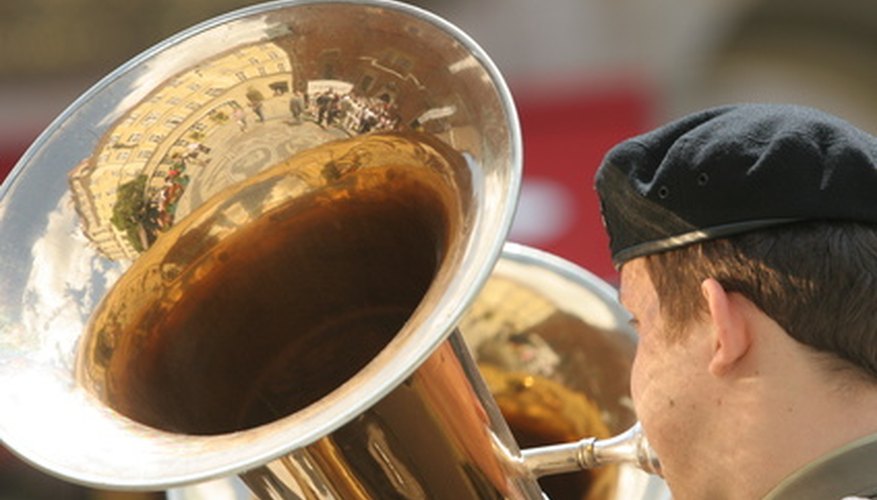A fanfare is a bold and brief piece of music used to announce the coming of an important person or event. You'll hear them at sporting competitions like the Olympics, at military and official government ceremonies, and often in movies or TV shows as opening theme music. Featuring dotted rhythms, repeated patterns and a harmonic series of notes, fanfares are generally brass- and percussion-dominant. This is both to get the listener's attention and impart a sense of importance to the event.
Brevity
One of the key characteristics of a musical fanfare is brevity. These musical works are intended to be introductory, a quick blast of sound to quiet the crowd and direct their attention to the stage. Some fanfares are very short, such as a 10- or 20-second call to arms or for horsemen to mount. Generally, fanfares do not exceed two to three minutes.
- One of the key characteristics of a musical fanfare is brevity.
- Some fanfares are very short, such as a 10- or 20-second call to arms or for horsemen to mount.
Volume
Fanfares are nearly always played fortissimo, or loud. Since the objective of the music is to command attention, volume and power are important factors. Historically, fanfares were played at hunts and coronation ceremonies before hundreds or thousands of spectators. In the days before electric amplification of sound, the music had to be loud enough to cut through the audience noise and announce the event was about to begin.
- Fanfares are nearly always played fortissimo, or loud.
- In the days before electric amplification of sound, the music had to be loud enough to cut through the audience noise and announce the event was about to begin.
Orchestration
The lead melody line in a fanfare is carried by the brass, particularly trumpets, coronets and bugles. The trombone, tuba and French horn are also employed heavily to accentuate the rhythm. Some fanfares may feature a solo passage played by one of these lower-range brass instruments for effect. Drums and percussion are meant to keep the tempo moving steadily forward, such as in military marches where the cadence is set for a fast-paced walk.
- The lead melody line in a fanfare is carried by the brass, particularly trumpets, coronets and bugles.
- Some fanfares may feature a solo passage played by one of these lower-range brass instruments for effect.
Features
Fanfares contrast passages using the harmonic series, usually in the lower register, with stepwise movement, usually in the higher register. They are usually played in major scales. The strong rhythmic character of a fanfare often employs repeated rhythms--semi-quavers, dotted rhythms and triplets--and repeated notes at the same pitch. Imitative, contrapuntal textures are contrasted with rhythmic chordal passages.
- Fanfares contrast passages using the harmonic series, usually in the lower register, with stepwise movement, usually in the higher register.
Famous Fanfares
Some examples of well-known fanfares throughout history are Igor Stravinsky's "Fanfare for a New Theatre," "Fanfare for St. Edmundsbury" by Benjamin Britten, Aaron Copland's seminal "Fanfare for the Common Man," film composer Alfred Newman's famous "20th Century Fox Fanfare," the "Majestic Fanfare" by Charles Williams and the "Olympic Fanfare and Theme," composed by John Williams for the 1984 Olympic Games. In modern rock music, the "Icarus Dream Fanfare," from the "Concerto Suite for Electric Guitar and Orchestra" by Yngwie Malmsteen is a favourite with budding guitarists practicing their craft.
